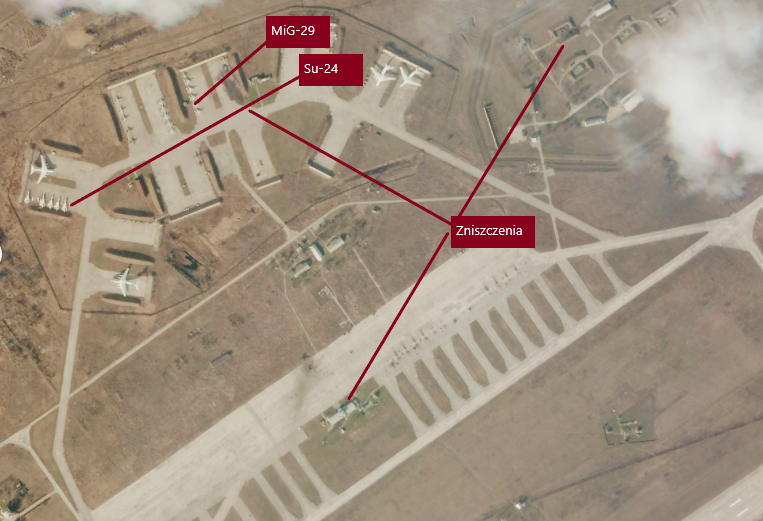PULASKI POLICY PAPER: Russian invasion of Ukraine – first military conclusions (Tomasz Smura)
Autor foto: Domena publiczna

Russian invasion of Ukraine – first military conclusions
February 28, 2022
Author: PhD Tomasz Smura




PULASKI POLICY PAPER: Russian invasion of Ukraine – first military conclusions (Tomasz Smura)
Autor foto: Domena publiczna
Russian invasion of Ukraine – first military conclusions
Author: PhD Tomasz Smura
Published: February 28, 2022
Pulaski Policy Paper no 3, 2022, February 28, 2022
On 24 February this year, the Russian Federation, after a phase of increased political-military pressure lasting several months, launched military aggression against Ukraine. After the fourth day of Russian offensive actions there are already clear conclusions as to the probable plans and military objectives of the Armed Forces of the Russian Federation. The main operational direction is undoubtedly the north (where the tactical units brought from the Eastern Military District operate), in particular along the axis running from the Belarusian border in the Chernobyl region, through Ivankov and then the sub-Kiev towns to the capital itself. The operational goal of the activities in this direction seems to be surrounding Kiev from the west with far-flung raids (including on the Vasylkovo airfield about 25 km southeast of Kiev) and cutting off the capital from the western part of the country and from outside assistance. The offensive on Kiev is also continuing on the eastern side of the Dnieper on the Chernihiv-Kiev axis, where, faced with the impossibility of conquering Chernihiv, Russian units are bypassing the city and attempting to continue the assault on the Ukrainian capital from the northeast.
In the eastern direction (where units from the Western MD, consisting of the 20th Guards Combined Arms Army, the 1st Guards Tank Army, and the 6th Combined Arms Army, among others, are operating) the objective is to surround the second largest city in Ukraine, Kharkiv (Russian reconnaissance units entered the city but were driven out, and the Russians have so far failed to capture the city of Sumy, located north of Kharkiv) , and more to the north – along the M02 highway – to close the ring around Kiev from the east. The strategic objective throughout the campaign thus appears to be to encircle the Ukrainian capital and force the Ukrainian authorities to capitulate by threatening to storm or destroy the city.
In the southern direction, where the Russians have made the most progress, units of the 22nd Army Corps operating from Crimea aim primarily to surround Mariupol and create a land corridor to the Donetsk People’s Republic. In contrast, Russian units in the south attacking in the western and northern directions have most likely already reached the Dnieper line, which will make it very difficult for them to advance further. Based on the course of the Russian aggression against Ukraine so far, the first broader military conclusions can also be drawn, which are also important for the states on NATO’s eastern flank, including Poland.
Massive air and missile attacks
The Armed Forces of the Russian Federation borrowed from the post-Cold War operations of the West (the Persian Gulf wars, the former Yugoslavia, Libya) the doctrine of breaking through the air defence system and interrupting the command and control (C2) system by massive air and missile attacks. Thus, in the first phase of the operation, early warning radars and air bases were attacked using cruise missiles launched from bombers and Black Sea Fleet ships (Raduga Ch-55/Ch-101 and 3M14 Kalibr missiles, respectively) and short-range ballistic missiles (9K720 Iskander). The emerging information about explosions in Kiev and other Ukrainian cities may in turn indicate attempts to destroy the command centers located there. In the case of NATO operations, however, the air and missile phase usually lasted much longer (e.g., 42 days during the First Gulf War) and was often not accompanied by a ground operation at all (e.g., the Allied Force operation against the Federal Republic of Yugoslavia) or was conducted with the aid of allied local forces (Afghanistan, Libya). In the case of Russian aggression against Ukraine, by contrast, the ground phase began only hours after the first missile attacks. This may be due to the fast pace of the entire operation, which stemmed from the desire to complete it quickly in order to avoid wider international repercussions (the Kremlin may have hoped that a short-lived war with relatively few casualties would limit the number of sanctions imposed on Russia). According to the Department of Defense, the Russian Armed Forces have probably not yet succeeded in breaking through the Ukrainian air defence system, which may also be evidenced by the (difficult to verify) information about further downed Russian aircraft. Nevertheless, according to reliable information provided by the U.S. Department of Defense, some 320 ballistic and cruise missiles fell on Ukrainian targets by the fourth day of the conflict, with about 100 targets attacked in the first salvo. Subsequent salvos were smaller, which is probably due to the time required to gather satellite information about further targets of attack.
Interestingly, short-range ballistic missiles (SRBM) were also to be used in the conflict by the Ukrainian side, as there were reports of an attack – most probably by the Tochka-U system – on the Russian air base in Millerovo near Rostov.

Nikolaev airbase after missile attacks on the 1st day of the war. Source: Skysat
Fighting for air superiority
As indicated in a recent report by the Casimir Pulaski Foundation,[i] control in the air is considered the starting point for achieving success in modern war campaigns. In this conflict, too, this aspect seems to be of great importance, as the Armed Forces of the Russian Federation have from the beginning focused their attention primarily on this dimension of operations. In general, according to information from the U.S. Department of Defense,[ii] 75 Russian aircraft were involved in the air operation against Ukraine, which corresponded to the number of Ukrainian aircraft (Ukraine’s fighter aviation before the conflict consisted of about 37 Mig-29s and about 34 Su-27s; the remaining combat aircraft were Su-24 and Su-25 strike aircraft, which totaled about 45),[iii] and according to Russian plans, a large part of Ukrainian aircraft were to be destroyed already on the ground as a result of the above-mentioned salvoes of ballistic and cruise missiles. In all likelihood, however, the Russians did not manage to eliminate all of Ukraine’s aviation potential in their first attacks (despite inflicting heavy losses – e.g. footage from the Ivano-Frankivsk airbase shows at least six destroyed MiG-29s), which is paradoxically confirmed by the crash/shootdown of a Ukrainian Su-27 over Kiev on 25 February. Also, the available satellite images of the attacked Ukrainian air bases (Chuvuyiv and Nikolaev bases) after the initial attacks indicated that only a limited number of airport infrastructure buildings and aircraft based there had been destroyed. The fact that Ukraine maintains at least some air and air defence potential seems to make it difficult for the Russians to carry out their actions, as can be seen from the need to use against Ukrainian targets, first of all, ballistic missiles (which are more expensive and have a more complicated targeting system, so their use against less demanding and mobile targets is ineffective), and to a lesser extent aviation.
Airborne troops raids and landings
Russian military operations in Ukraine appear to be aimed at achieving quick victory and minimising casualties. Thus the Russian forces are focused not so much on capturing all of Ukraine as on a quick encirclement and subsequent capture of Kyiv (with potential territorial gains to be secured in the south). Hence, the Russian troops are abandoning the assaults on larger and well-defended cities (Kharkiv, Chernihiv) and are trying to bypass them in order to continue their advance toward the Ukrainian capital. At the same time, the Russians are attempting to make their operations more dynamic by rallying airborne troops, which seems to fit strongly into Russian doctrine. As many as 45,000 soldiers are serving in Russian airborne units, which comprise 4 airborne/air assault divisions and 3 independent air assault brigades[iv]. At the same time, the Russian airborne troops have at their disposal capabilities rarely seen in such units (usually light units due to their high mobility), such as main battle tanks (T-72B3) and infantry fighting vehicles. Already on the first day of the operation Russian air cavalry units attempted to capture Hostomel airfield located only about 25 km from the center of Kyiv. Eighteen heavy IL-76 aircraft were to land there with subunits of the 76th Guards Air Assault Division from Pskov to establish a strong bridgehead north of Kiev, which would be quickly reached by heavier troops coming from the Belarus border. However, the Russian attack was repulsed within hours by the Ukrainian defenders of the airfield, and the Russian units had to withdraw. The Russians, however, continued long rallies in the northern direction with the help of diversionary units, whose presence was noted in the Kiev district of Obolon. Another Russian airborne attack, as mentioned, took place on the Vasylkovo airfield located about 25 km southeast of Kiev, with the aim of gaining another foothold for troops intended to surround the Ukrainian capital from the west. According to reports from the Ukrainian side, this also failed and the airfield was retained (the Russians lost one IL-76 aircraft, which has not yet been unequivocally confirmed by other sources).
In the south, the Russians are pursuing, with more success, the tactic of capturing advanced bridgeheads with the help of naval infantry units operating from amphibious ships. According to information provided by the U.S. Department of Defense, such a landing using four ships was dropped west of Mariupol to surround the city[v]. Information about Russian landings also appeared in the context of Nikolaev and Odessa, located north-west of Crimea.
Guided anti-tank missiles and drones
Another conclusion that can be drawn from the Russian aggression against Ukraine is the high effectiveness of anti-tank guided missiles against Russian tanks and infantry fighting vehicles. In fact, there are a number of credible photos in the public domain of destroyed Russian tanks of the T-72B3 family and even T-90s, most likely hit by FGM-148 Javelin and NLAW missiles, which were supplied to Ukraine by the U.S. and Britain. Thus the capabilities of the active and passive defence systems mounted on Russian tanks (e.g. the Kontakt-5 explosive reactive armour) seem to be greatly overestimated.
The unmanned Bayraktar TB2 systems acquired by Ukraine have also proved effective; in the footage presented by the Ukrainian army, the drone approaches Russian columns, destroying selected vehicles, including 9K37 Buk air defence systems. Such a possibility appeared either due to the mistakes of the Russian side (lack of short-range anti-aircraft defence for the column), or once again (after the experience in Syria) the Russian anti-aircraft defence systems failed, which would also indicate that their capabilities were overestimated.
De-escalation by escalation
Finally, it is worth noting the Russians’ practical, though of course limited and non-literal, recourse to the doctrine of de-escalation through escalation (a tactic attributed to the Russian side of limited use of tactical nuclear weapons, e.g. in uninhabited territory, to induce the adversary to cease further action). On the fourth day of the conflict, in the face of seemingly unsatisfactory progress on the part of the Russian armed forces and further reports of military assistance to Ukraine from Western countries, Russian President Vladimir Putin announced the placing of the Russian deterrence forces on special combat readiness. Although any use of nuclear weapons in this conflict is highly unlikely, further recourse to nuclear blackmail against Ukraine and the West is to be expected, especially if the conflict turns even more strongly against Russia.
Conclusions
1. After four days of Russian aggression against Ukraine, Russia’s strategic and operational objectives have already clearly emerged. The main operational course in the Russian campaign is the northern direction, and the goal of operations in this direction seems to be to surround Kiev from the west, including by means of far-flung raids and cutting off the capital from the western part of the country and external assistance. Operations in the eastern direction are aimed at closing a ring around Kiev from the east.
2. Russia has placed a very heavy emphasis in the operation on gaining dominance in the air. This is achieved by intensive missile attacks on Ukrainian targets, which have led to the destruction of at least part of the Ukrainian combat aviation potential. The appropriate conclusions must be drawn in Poland as well, such as a greater dispersion of planes in air bases, the necessity to prepare backup bases in the western part of the country and increasing the number of highway strips to which planes can be transferred already during the growing crisis. It is unacceptable to gather the whole essential potential of the Polish Air Force in two air bases (Łask and Krzesiny), as it seems to be planned now. It should also be noted that in the case of Ukraine the most difficult to quickly recover losses will be the combat aviation (among others, due to highly specialised personnel). Poland therefore needs to increase the number of combat aircraft capable of winning and maintaining air superiority, as it will be impossible to restore losses in a conflict, especially one of short duration.
3. The Russian armed forces make extensive use of airborne troops and infantry units to establish advanced bridgeheads. It is therefore necessary to ensure good protection of the hinterland of frontline units and an adequate degree of protection for important infrastructure facilities (especially airfields), which should be the task of territorial defence units.
4. The saturation of the Polish Armed Forces sub-units with anti-tank guided missiles, which have demonstrated high effectiveness against Russian active and passive defence systems, should be rapidly increased. Also highly effective are unmanned systems that maintain operational capability even in the face of enemy air superiority and its saturation with anti-aircraft defence systems.
5. In its actions Russia often resorts to direct and indirect nuclear blackmail. It is therefore necessary to plan an action scenario (including strategic communications) in the event of possible threats to use nuclear weapons and to prepare the civilian population for such a scenario in good time through information and education.
Author: PhD Tomasz Smura, Director of the Research Office of the Casimir Pulaski Foundation
[i] Polskie Siły Powietrzne w operacjach XXI wieku – spojrzenie w przyszłość i rekomendacje, ed. Tomasz Smura, Rafał Lipka (Warszawa: Fundacja im. Kazimierza Pułaskiego, 2022).
[ii] “Senior Defense Official Holds an Off-Camera Press Briefing,” Department of Defense, accessed February 28, 2022 https://www.defense.gov/News/Transcripts/Transcript/Article/2947562/senior-defense-official-holds-an-off-camera-press-briefing.
[iii] Military Balance, (London: Routledge, 2021), p. 210.
[iv] Ibid., p. 199.
[v] “Senior Defense”.





